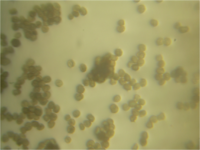
Photo from wikipedia
ABSTRACT Ustilago maydis causes common smut disease in maize. Although pathogenic diploid strains of the fungus have been known for many years, the normal life cycle was thought to involve… Click to show full abstract
ABSTRACT Ustilago maydis causes common smut disease in maize. Although pathogenic diploid strains of the fungus have been known for many years, the normal life cycle was thought to involve an extended dikaryotic stage, with nuclear fusion occurring in immature teliospores. However, microscopic examination of both living and fixed tumor material showed that nuclei fuse long before sporulation begins and that tumors are filled with uninucleate cells undergoing mitosis. Quantification of DNA in the nuclei confirmed these observations. Additionally, fungal cells from tumor material placed on nutrient agar produced colonies of diploid budding cells. Time-lapse observations showed that at least some of these colonies arose from thin-walled fungal cells rather than from immature spores. Ultrastructural examination of developing teliospores from tumors confirmed that they were uninucleate. Condensed chromatin and other structures characteristic of nuclei in prophase I of meiosis were observed. These observations support revising the U. maydis life cycle to include a diploid mitotic stage that corresponds with rapid tumor enlargement and conversion of plant to fungal biomass. Because mitotic division of diploid nuclei is so unusual as a life cycle feature in the fungi, it will be interesting to explore the consequences of its presence in U. maydis.
Journal Title: Mycologia
Year Published: 2017
Link to full text (if available)
Share on Social Media: Sign Up to like & get
recommendations!